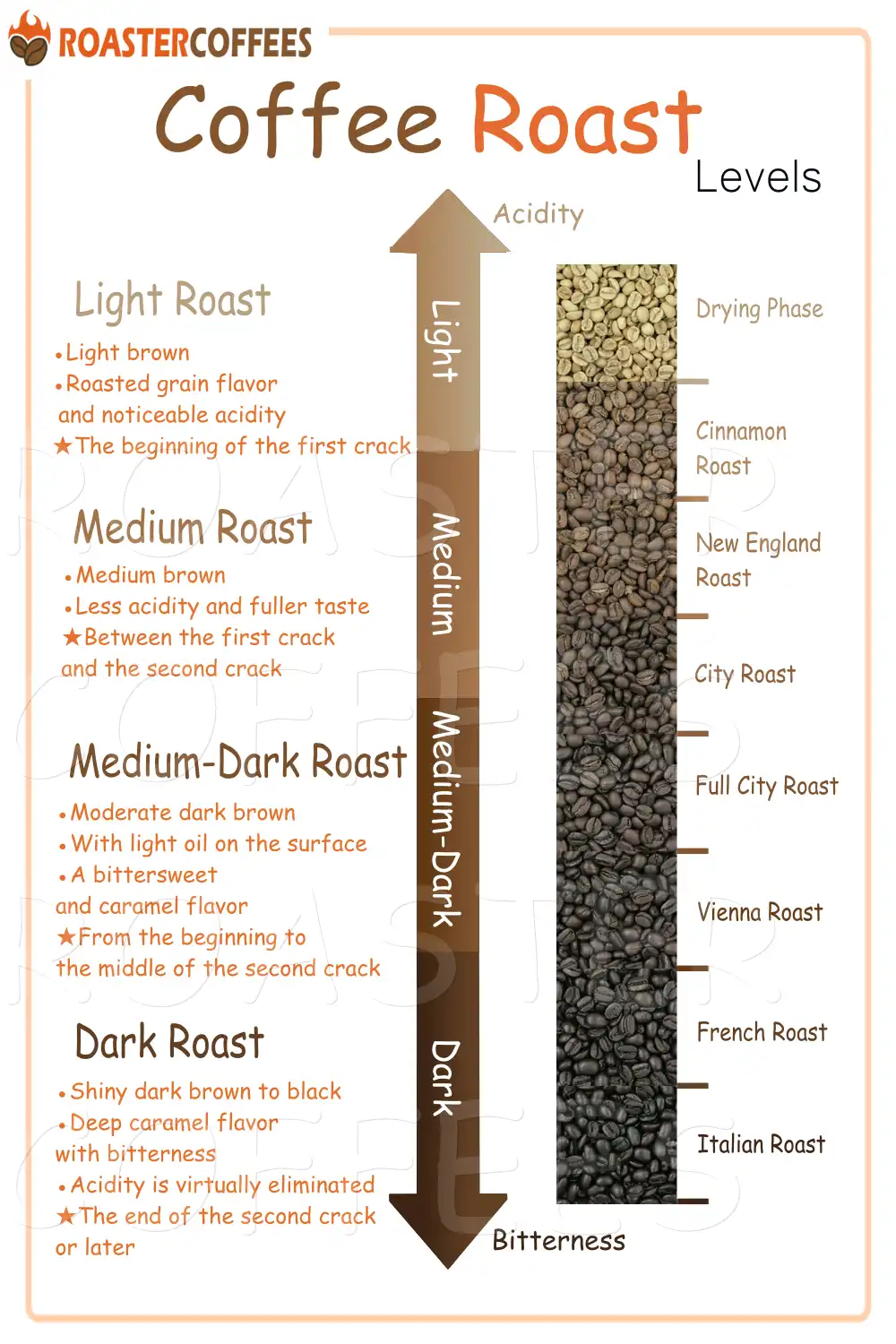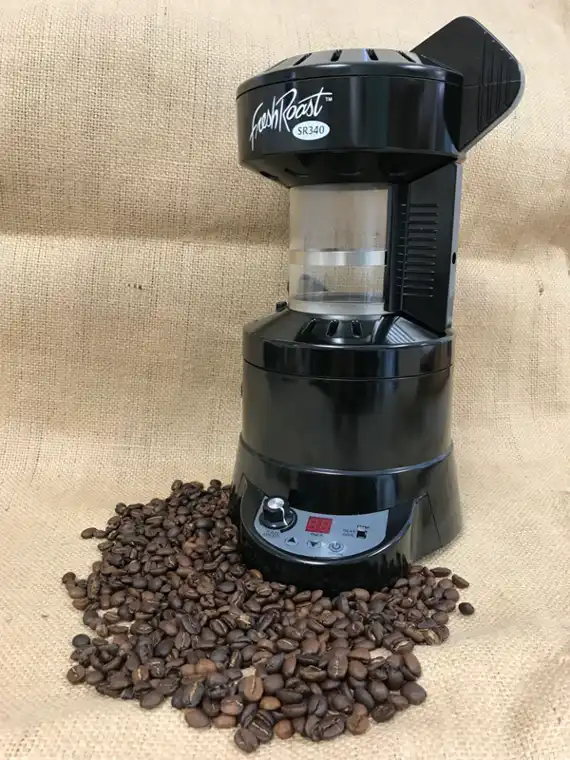
Home coffee roasting means that you can drink fresh coffee anytime, anywhere, and with some practice, you can ensure that the coffee is roasted precisely to your taste. Although you can always find this type of coffee in your local coffee shop or roaster, why not roast it yourself?
Freshness is an important factor. You can store green beans for a year without deterioration after harvest. However, roasted beans will begin to lose their aroma and flavor after only a few weeks. Every week or even every day, buying green beans and roasting a small amount will ensure that your coffee is always fresh.
During the coffee roasting process, the coffee beans will take place in some physical and chemical changes. Eventually, many pores are produced in the coffee beans so that oxygen and moisture can easily penetrate the beans, causing them to oxidize and gradually lose their flavor.
So once you roasted them, you should use them as soon as possible before the fresh-roasted flavor begins to lose. The result is that you should roast coffee at home regularly to ensure the freshness of the coffee beans.
It sounds troublesome, but once you start roasting, you will fall in love with it.
You can make great coffee from start to finish at home. It makes you start to understand what makes your favorite coffee taste so delicious and how to change the roasting configuration or buy different coffee beans to highlight this. Your taste buds will be improved through time and practice, and you will appreciate your coffee more.
Believe us, as long as you have completed home coffee roasting once, and then use the beans you roasted to brew a delicious cup of coffee. You will fall in love with it.
What Happens During Coffee Roasting?
During the roasting process, coffee beans’ weight is often reduced by about 15% to 18% due to the loss of moisture and volatile compounds. Although the coffee beans have experienced weight loss, the cellulose structure’s physical expansion promotes the release of CO2, volatile organic compounds, and water (in the form of steam). So after the roasting process, the size of the coffee beans will increase by 50% to 100%.
Once the roasting process is complete, the coffee will begin degassing. Due to increased porosity, the roasted beans are more susceptible to oxidize. And in one or two weeks, they will have started to lose some of their flavor and aroma. Depending on the roasting level, the time will vary. The darker the roasting, the faster the flavor will be lost.
The Coffee Roasting Levels
Professional roasters have identified several roasting levels that beans can, but not necessarily should go through. Which level you can reach will depend on you.
- Green Beans: Usually light green, the color varies slightly depending on the place of origin. You can usually store the beans in a climate-controlled environment for approximately 12-18 months.
- Drying Phase: When green coffee beans enter a high-temperature environment, the moisture content begins to drop. It is the drying stage. Soon after entering this stage, the coffee beans start to turn yellow. Many people call this the yellowing phase.
- Cinnamon Roast: This stage is lightly roasted, light brown, roasted grain flavor, and noticeable acidity. At this stage, the first crack will occur, and you will recognize it by a series of popping sounds.
- New England Roast: At this point in the roast, we are in the middle of the first crack. It shows a moderately light brown but still a mottled appearance. It is the first choice for some professional roasters, highlighting the origin characteristics and complex acidity.
- American Roast: It is traditional roasting in the eastern United States, and it is roasted until the first crack ends. It shows Medium light brown with slightly reduced acidity.
- City Roast: Coffee is usually roasted to this level, which can well reflect the taste of the coffee beans themselves, which is the lowest roasting level acceptable to most people. It shows medium brown and is a typical barbecue throughout the United States.
- Full City Roast: The coffee beans show medium-dark brown, dry to tiny droplets or faint oil spots, and outstanding roasting characteristics. It takes the beans to the beginning of a second cracking.
- Vienna Roast: The coffee beans are moderate dark brown with light oil on the surface. It has a more bittersweet and caramel flavor while the acidity is muted. It is roasted to the middle of the second crack.
- French Roast: Coffee beans are dark brown, shiny, deep caramel flavor, and acidity diminished. It was roasted to the end of the second crack. It has more roasting characteristics and almost obscures the inherent aroma and taste of the coffee.
- Italian Roast: The coffee beans are roasted to almost black with a bitter taste. The beans’ surface is shiny, which the burnt tones are more apparent. And the acidity is virtually eliminated.
It should also be noted that some charts contain more or less roasting distinctions than our points above. We only included the parts that marked the difference in the roasting process, not every minute distinction.
People often have different preferences, and they want their coffee roasting to fall on the stage list above. But they may not know all the distinguish. The most basic and commonly used denominations are used to determine light, medium, medium-dark, and dark roasting stages.
Light Roast

For light roasts, including Cinnamon Roast and New England Roast, the roasting process’s internal temperature usually reaches 356°F to 401°F. Some other common names are Light City and Half City. But no matter the name, they tend to fall near the beginning of the first crack.
You will choose this roast if you favor higher acidity. Thanks to it require less time and a lower temperature, this roast is also safer to do at home.
Medium Roast

American Roast and City Roast are Medium Roast. Medium Roast ends at the end of the first crack and before the start of the second crack, which internal temperature is between 410°F and 428°F.
This roast is more popular than the light roast due to the medium level of acidity and fuller taste. Besides, the temperature can still be controlled for most people.
Medium-Dark Roast

The beans are roasted to the beginning or middle of the second crack for medium-dark roasting, and the internal temperature is about 437-446°F. It includes Full-City Roast and Vienna Roast.
The taste of roasting begins to stand out, thereby increasing the aroma of spices. Compared with light or medium roast, the medium-dark roast has a heavier body.
Dark Roast

Some of the more famous names for dark roasts include French Roast, Italian Roast, and Espresso Roast. The coffee beans will be roasted to the end of the second crack or later, and their internal temperature is around 465°F-480°F. When the correct equipment is not used, higher temperatures may be dangerous.
Dark roasts usually have a bitter, smoky, or even burnt taste. Most black roasts are used for espresso.
Following is a chart covering the roasting stages and levels introduced above. It will help your roasting and brewing every time.
You can download it to any of your devices so that you can view it anytime, anywhere. Of course, it’s free!

What You Need For Home Coffee Roasting
What you need:
Green Coffee Beans
If you know that there is a local coffee shop roasting their coffee beans, you may get good luck from them, or check whether roasters in your area sell unroasted coffee beans. However, the easiest way is to find coffee online.
Roaster
The roaster choice depends on your budget, how much coffee you want to roast, and how much control you want for the roasting variables.
Popcorn machines are easy to use and usually produce an even roast. They are a good starting point for roasting in small amounts. However, please keep in mind that doing so will invalidate your machine’s warranty, and you cannot use devices with a mesh screen on the bottom, as this may cause a fire.
Home coffee roasters are used to roast more coffee and better control the roasting process.

Storage Container
After roasting, you need a container to store the coffee until it is used. Remember, the better the seal, the better. However, even the best box cannot prevent the coffee from losing its aroma and flavor if left for about a week. Finally, remember to put the container in a cool, dark place.
During the roasting process, adequate ventilation is essential for your roasting quality and your safety.
Now that everything is ready, you can start your home coffee roasting. Below we will introduce how to set up commonly used home coffee roasting machines and popcorn machines.
How To Use Home Coffee Roaster
If you have bought a home coffee roaster, the manual will tell you the different profiles. It is a good idea to start with a preset until you are more acquainted with the roasting process.
So far, this is the easiest one among all home coffee roasting methods because the roaster can handle most of the heavy tasks for you. You usually need to do the following:
- According to the manual, add an appropriate amount of green beans.
- Close the roaster, set the roasting temperature (or use the preset value, if available), and then turn it on.
- Wait for the beans to roast to the desired color. The darker the color, the longer the roasting time.
- If it is a machine with an automatic cooling program, you just need to wait. If not, you need to pour out the roasted beans first.
- You can use a small sieve and fan to blow air through the roasted beans, helping remove some chaff and speed up cooling.
- Once the roasted beans reach room temperature, they can be stored. Heat, light, and oxidation are the enemies of freshly roasted beans, so you can take any measures to avoid these problems.
Since freshly roasted beans gradually release CO2 (degassing), they cannot be vacuum packed (the bag may be blown open). For immediate packaging, you can choose a coffee bag with a one-way exhaust valve.
Hot Air Popcorn Popper For Coffee Roasting
The popcorn machine is not only used for popcorn. You can try roasting in just a few minutes. Then, let’s start a home coffee roasting on an air popcorn popper.
1.Preheat
Before starting, empty the tabletop to leave enough space. Prepare the popcorn maker, bowl (for receiving the chaff), and roasting tray (for cooling the coffee beans). Turn on the popcorn machine and preheat for 30 seconds.
2.Add Coffee Beans
After the preheating is complete, pour an appropriate amount of mung beans into the machine.
3.Roast Coffee Beans
Start roast beans. It only takes about 5 minutes. You need to observe the coffee beans throughout the process and stop roasting at an appropriate time according to the degree of roasting required. Please remember: do not leave it alone!
4.Cool Coffee Beans
When the desired roasting level is reached, turn off the popcorn machine and pour the beans on the roasting tray to cool. To speed up the cooling rate, shake the tray until thoroughly cooled.
5.Store Coffee Beans
Just like when using a home coffee roaster for coffee roasting, you can use a coffee bag with a one-way exhaust valve to store roasted coffee beans.
Remember, beans roasted by any method should not be immediately ground and brewed. It would help if you let your beans release enough CO2 (degassing). Otherwise, they will destroy the aroma and flavor of the coffee.
But if the degassing time is too long, it will affect the freshness of the beans. Ideally, wait at least three days or so. You will want the brewed coffee to be closer to the roast date for darker roasts because the darker roasting process releases a lot of gas.
Final
Take your time and enjoy the fruits of your labor. When you roast coffee at home, try to use different methods to roast coffee beans for various time periods to find a home coffee roasting that perfectly suits your taste preferences.
However, please remember that no matter which method you use for coffee roasting at home, you must pay attention to safety, maintain good ventilation, and avoid fire. Never leave your coffee beans alone during the roasting process, as this may burn your beans. Worse still, it may cause a fire!
Home Coffee Roasting FAQs
How To Avoid Common Home Coffee Roasting Mistakes?
Although home coffee roasting is relatively easy, some easy mistakes can bring disaster to your coffee beans.
Don’t be bound by your roasting time, and you may need to change it sometimes. For example, roasting outdoors may mean that your machine will take longer to warm up. Failure to adjust this may result in underdeveloped beans and insufficient roasting.
The quantity of each roasting will also affect the roasting time and ideal temperature. You may use such a large amount that the coffee beans cannot absorb heat evenly in the roaster.
Try to balance the batch size and the roaster’s heating application until you have enough time to make the roast even. If your roasting time is long and the coffee beans still heat unevenly, try reducing the batch size!
Using a higher temperature setting to achieve a faster roasting time may cause the beans to burn. During the roasting process, pay attention to your temperature readings, the coffee’s color and aroma, and the first and second cracks.
Please note that keeping the roaster clean is very important. The oil and chaff will accumulate, causing problems for future roasting, and even fires may occur.
Finally, please remember not to leave the roaster. Roasting may change quickly. Always pay attention to your roasting.
How To Make Your Home Coffee Roasting Better?
Practice will make your roasting technique better. Remember, there is no perfect roasting method. That is the joy of roasting coffee beans! You will be happy to find some improvements in each roasting process and enjoy roasting again.
Keep your variables consistent, so you can better understand their impact. Try to change only one variable at a time and see what happens and how it affects coffee beans’ flavor and aroma.
Finally, please keep a roasting diary. Every roasting you do should be recorded so that you can look back at the most effective method.
How To Choose A Coffee Roast?
First, you need to know the characteristics of different roast levels. You can get the free chart we provide covering various roasting stages and levels from the above article.
Remember one important point: the darker the roast, the bitterness increases, the acidity decreases, the flavor of their origin is gradually lost, and the flavor of the roast gradually increases.
According to your preferences, try coffee beans from different origins and different roast levels to find out which coffee roast is suitable for you.
References
- XiujuWangLoong-TakLim (July 2014). “Effect of roasting conditions on carbon dioxide degassing behavior in coffee”.
- S. Schenker, S. Handschin, B. Frey, R. Perren, F. Escher. (28 June 2008). “Pore Structure of Coffee Beans Affected by Roasting Conditions”.







